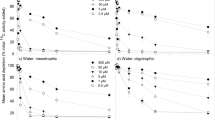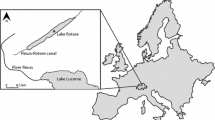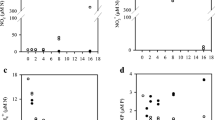Abstract
Abundance of d isomers of amino acids has been used in studies of organic matter diagenesis to determine the contribution of bacterial biomass to the organic matter, especially in marine sediments. However, fluxes of d amino acids in pelagic waters are poorly known. Here we present seasonal changes (March–September) in concentrations of dominant d amino acids in the pool of dissolved free and combined (hydrolysable) amino acids (DFAA and DCAA) in the shallow Roskilde Fjord, Denmark. The amino acid dynamics are related to pelagic bacterial density and activity and abundance of viruses. d␣isomers made up 3.6 and 7.9% of the DFAA and DCAA (average values), respectively, and had similar seasonal variations in concentrations. In batch cultures (0.7- and 0.2-m filtered water in a 1:9 mixture) microbial activity reduced l+d DCAA concentrations in seven of ten sampling dates, while DCAA were released at the remaining three sampling times. NH +4 balance (uptake or release) in the cultures correlated significantly with variations in concentrations of d-DCAA, but not with the total DCAA pools. Abundance of viruses did not correlate with density or production of bacteria in the fjord, but covaried with mineralization of total C, DCAA and PO 3−4 in the batch cultures. The content of d amino acids in bacterial biomass in the cultures varied from 6.7 to 12.5% and correlated with the d isomer concentration in the fjord, except for d-Ala. In an additional six-day batch culture study, DCAA and d-DCAA were assimilated by the bacteria during the initial 36 h, but were released between 36 and 42 h simultaneous with a decline in the bacterial density. Our results demonstrate that peptidoglycan components contribute to natural amino acid pools and are assimilated by bacterial assemblages. This cell wall “cannibalism” ensures an efficient recycling of nutrients within the microbial community. Significant positive correlations between viral abundance and bacterial mineralization of organic matter in the fjord indicated that viral lysis contributed to this nutrient recycling.
Similar content being viewed by others
References
Azam F, Fenchel T, Field JG, Gray JS, Meyer-Reil L-A and Thingstad TF (1983) The ecological role of water-column microbes in the sea. Mar Ecol Prog Ser 10:257–263
Bada JL (1982) Racemization of amino acids in nature. Interdisc Sci Rev 7:30–46
Benner R (2002) Chemical composition and reactivity. In: Hansell DA, Carlson CA (eds) Biogeochemistry of marine dissolved organic matter. Academic Press, Amsterdam, pp 59–90
Bronk DA (2002) Dynamics of DON. In: Hansell DA, Carlson CA (eds) Biogeochemistry of marine dissolved organic matter. Academic Press, Amsterdam, pp 153–249
Brückner H, Haasmann S, Langer M, Westhauser T, Wittner R and Godel H (1994) Liquid-chromatographic determination of d-amino and l-amino acids by derivatization with o-phthaldialdehyde and chiral thiols. J Chromatogr A 666:259–273
Cibik R, Tailliez P, Langella P, Chapot-Chartier MP (2001) Identification of Mur, an atypical peptidoglycan hydrolase derived from Leuconostoc citreum. Appl Environ Microbiol 67:858–864
Fuhrman JA, Azam F (1980) Bacterioplankton secondary production estimates for coastal waters of British Colombia, Antactica, and California. Appl Environ Microbiol 39:1085–1095
Giesbrecht P, Kersten T, Maidhof H, Wecke J (1997) Two alternative mechanisms of cell separation in staphylococci: one lytic and one mechanical. Arch Microbiol 167:239–250
Giesbrecht P, Kersten T, Maidhof H, Wecke J (1998) Staphylococcal cell wall: morphogenesis and fatal variations in the presence of penicillin. Microbiol Mol Biol Rev 62:1371–1414
Gobler CJ, Hutchins DA, Fisher NS, Cosper EM and Sanudo-Wilhelmy SA (1997) Release and bioavailability of C, N, P, Se, and Fe following viral lysis of a marine chrysophyte. Limnol Oceanogr 42:1492–1504
Grutters M, van Raaphorst W, Epping E, Helder W, de Leeuw JW, Glavin DP, Bada JL (2002) Preservation of amino acids from in situ-produced bacterial cell␣wall peptidoglycans in northeastern Atlantic continental margin sediments. Limnol Oceanogr 47:1521–1524
Hobbie JE, Daley RJ, Jasper S (1977) Use of nucleopore filters for counting bacteria by fluorescence microscopy. Appl Environ Microbiol 33:1225–1228
Jespersen A-M, Christoffersen K (1987) Measurements of chlorophyll-a from phytoplankton using ethanol as extraction solvent. Arch Hydrobiol 109:445–454
Jørgensen NOG (1992) Incorporation of tritiated leucine and tritiated valine into protein of freshwater bacteria: uptake kinetics and intracellular isotope dilution. Appl Environ Microbiol 58:3638–3646
Jørgensen NOG, Jensen RE (1997) Determination of dissolved combined amino acids using microwave-assisted hydrolysis and HPLC precolumn derivatization for labeling of primary and secondary amines. Mar Chem 57:287–297
Jørgensen NOG, Kroer N, Coffin RB, Hoch MP (1999a) Relations between bacterial nitrogen metabolism and growth efficiency in an estuarine and an open-water ecosystem. Aquat Microb Ecol 18:247–261
Jørgensen NOG, Tranvik LJ, Berg GM (1999b) Occurrence and bacterial cycling of dissolved nitrogen in the␣Gulf of Riga, the Baltic Sea. Mar Ecol Prog Ser 191:1–18
Jørgensen NOG, Kroer N, Coffin RB, Yang XH, Lee C (1993) Dissolved free amino acids, combined amino␣acids, and DNA as sources of carbon and nitrogen to marine bacteria. Mar Ecol Prog Ser 98:135–148
Jørgensen NOG, Stepanaukas R, Pedersen AGU, Hansen M and Nybroe O (2003) Occurrence and degradation of peptidoglycan in aquatic environments. FEMS Microbiol Ecol 46:269–280
Karner M, Fuks D, Herndl GJ (1992) Bacterial activity along a trophic gradient. Microb Ecol 24:243–257
Keil RG, Kirchman DL (1991) Dissolved combined amino acids in marine waters as determined by a vapor-phase hydrolysis method. Mar Chem 33:243–259
Keil RG, Kirchman DL (1993) Dissolved combined amino acids: chemical form and utilization by marine bacteria. Limnol Oceanogr 38:1256–1270
Kirchman DL, Dittel AI, Malmstrom RR, Cottrell MT (2005) Biogeography of major bacterial groups in the Delaware estuary. Limnol Oceanogr 50:1697–1706
Kirchman DL, K’ness E, Hodson R (1985) Leucine incorporation and its potential as a measure of protein syntesis by bacterial in natural aquatic systems. Appl Environ Microbiol 49: 599–607
Kuznetsova M, Lee C, Aller JY (2005) Characterization of the proteinaceous matter in marine aerosols. Mar Chem 96:359–377
Lee C, Bada JL (1977) Dissolved amino acids in the equatorial Pacific, the Sargasso Sea, and Biscayne Bay. Limnol Oceanogr 22:502–510
Lewis K (2000) Programmed death in bacteria. Microbiol Mol Biol Rev 64:503–514
Lindroth P, Mopper K (1979) High performance liquid chromatographic determination of subpicomole amounts of amino acids by precolumn fluorescence derivatization with o-phthaldialdehyde. Anal Chem 51:1667-1674
Madigan MT, Martinko JM (2006) BROCK biology of microorganisms. Prentice Hall, Upper Saddle River, NJ
Matsumoto M, Homma H, Long ZQ, Imai K, Iida T, Maruyama T, Aikawa Y, Endo I, Yohda M (1999) Occurrence of free d-amino acids and aspartate racemases in hyperthermophilic archaea. J Bacteriol 181:6560–6563
McCarthy MD, Hedges JI, Benner R (1998) Major bacterial contribution to marine dissolved organic nitrogen. Science 281:231–234
Mercier C, Domakova E, Tremblay J, Kulakauskas S (2000) Effects of a muramidase on a mixed bacterial community. FEMS Microbiol Lett 187:47–52
Middelboe M (2006) Microbial disease in the sea: effects of viruses on marine carbon and nutrient cycling. In: Eviner VT et al. (eds), Ecology of infectious diseases. Springer, Berlin (in press)
Middelboe M, Jørgensen NOG (2006) Viral lysis of bacteria: an important source of dissolved amino acids and cell wall compounds. J Mar Biol Ass UK 86:605–612
Middelboe M, Borch NH, Kirchman DL (1995) Bacterial utilazation of dissolved free amino acids, dissolved combined amino acids and ammonium in the Delaware Bay estuary: effects of carbon and nitrogen limitation. Mar Ecol Prog Ser 128:109–120
Moak M, Molineux IJ (2004) Peptidoglycan hydrolytic activities associated with bacteriophage virions. Mol Microbiol 51:1169–1183
Mopper K, Furton KG (1999) Extraction and analysis of polysaccharides, chiral amino acids, and SFE-extractable lipids from marine POM. Geophys Monogr 63:151–160
Moriarty DJW, Hayward AC (1982) Ultrastructure of bacteria and the proportion of gram-negative bacteria in marine sediments. Microb Ecol 8:1–14
Mulvaney RL, Bremer JM (1979) A modified diacetyl monoxime method for colorimetric determination of urea in soil extracts. Comm Soil Sci Plant Anal 10:1163–1170
Nagata T, Kirchman DL (2001) Bacterial mortality: a pathway for the formation of refractory DOM? In: Microbial Biosystems: New Frontiers. Proceedings of the 8th International Symposium on Microbial Ecology 1:153–158
Nagata T, Meon B, Kirchman DL (2003) Microbial degradation of peptidoglycan in seawater. Limnol Oceanogr 48:745–754
Noble RT, Fuhrman JA (1998) Use of SYBR Green I for rapid epifluorescence counts of marine viruses and bacteria. Aquat Microb Ecol 14:113–118
Pedersen AGU, Thomsen TR, Lomstein BAa., Jørgensen NOG (2001) Bacterial influence on amino acid enantiomerization in a coastal marine sediment. Limnol Oceanogr 46:1358–1369
Perez MT, Pausz C, Herndl GJ (2003) Major shift in bacterioplankton utilization of enantiomeric amino acids between surface waters and the ocean’s interior. Limnol Oceanogr 48:755–763
Pollack GE, Kvenvolden KA (1978) Stereochemistry of amino acids in surface samples of a marine sediment. Geochim Cosmochim Acta 42:1903–1905
Price NM, Harrison PJ (1987) Comparison of methods for the analysis of dissolved urea in seawater. Mar Biol 94:307–317
Riemann L, Middelboe M (2002) Viral lysis of marine bacterioplankton: implications for organic matter cycling and bacterial clonal composition. Ophelia 56: 57–68
Rydman PS, Bamford DH (2002) Phage enzymes digest peptidoglycan to deliver DNA. ASM News 68: 330–335
Smith TJ, Blackman SA, Foster SJ (2000) Autolysins of Bacillus subtilis: multiple enzymes with multiple functions. Microbiology 146:249–262
Stepanaukas R, Laudon H, Jørgensen NOG (2000) High DON bioavailability in boreal streams during a spring flood. Limnol Oceanogr 45:1298–1307
Tanoue E, Nishiyama S, Kamo M, Tsugita A (1995) Bacterial membranes—Possible source of a major dissolved protein in seawater. Geochim Cosmochim Acta 59:2643–2648
Ugorakova J, Bukovska G (2003) Lysins and holins: tools of phage-induced lysis. Biologia 58:327–334
Weinbauer MG (2004) Ecology of prokaryotic viruses. FEMS Microbiol Rev 28:127–181
Zubkov MV, Sleigh MA (1998) Heterotrophic nanoplankton biomass measured by a glucosaminidase assay. FEMS Microbiol Ecol 25:97–106
Acknowledgements
We wish to thank R. E. Jensen and A.-S. B. Hentze for skilful technical assistance during field and laboratory work, and S. Hedal and B. Hansen at Roskilde County Administration for providing water samples for the study. This study was supported by grants from the Danish Natural Science Research Council to NOGJ and MM.
Author information
Authors and Affiliations
Corresponding author
Rights and permissions
About this article
Cite this article
Jørgensen, N.O., Middelboe, M. Occurrence and Bacterial Cycling of d Amino Acid Isomers in an Estuarine Environment. Biogeochemistry 81, 77–94 (2006). https://doi.org/10.1007/s10533-006-9031-9
Received:
Accepted:
Published:
Issue Date:
DOI: https://doi.org/10.1007/s10533-006-9031-9




